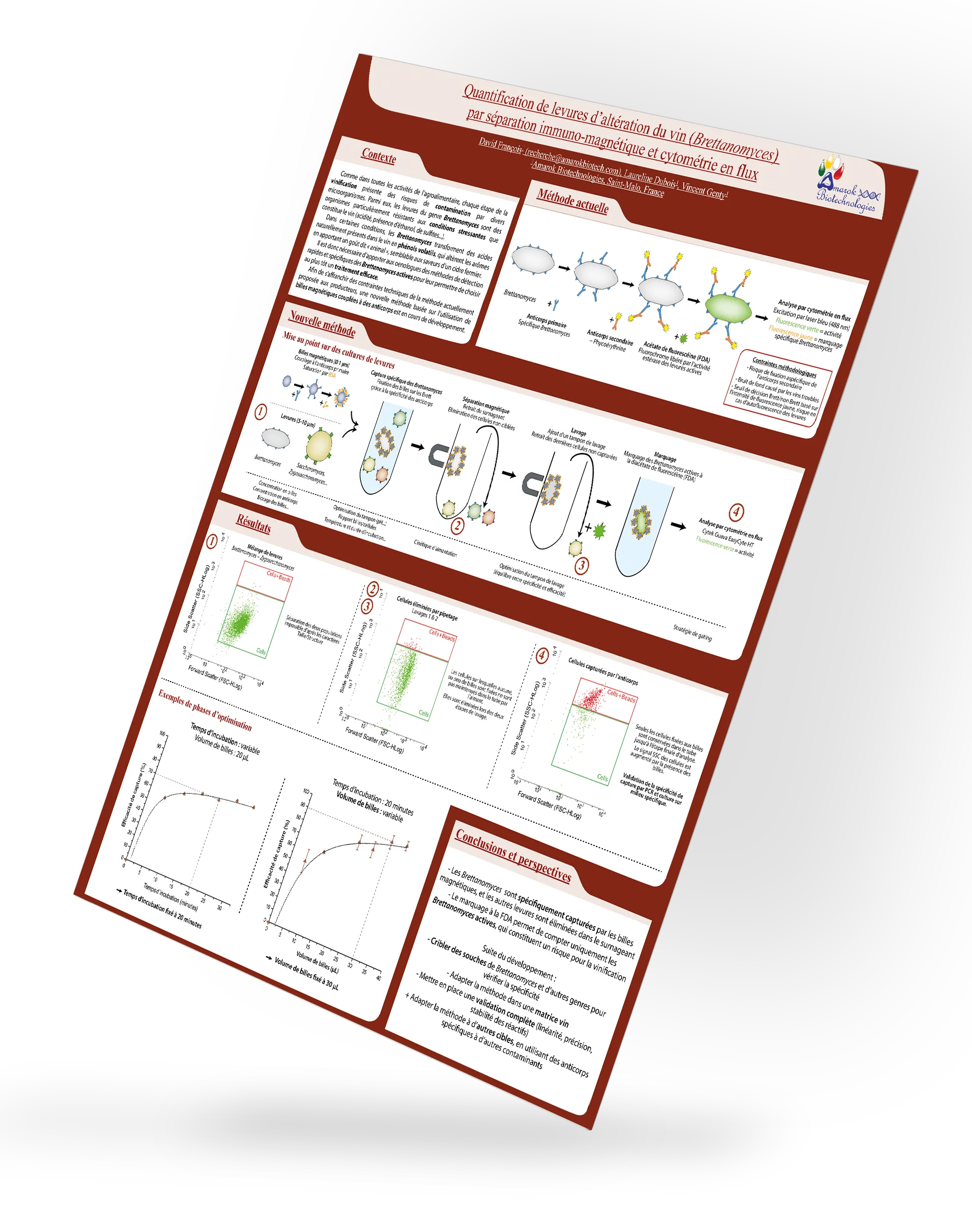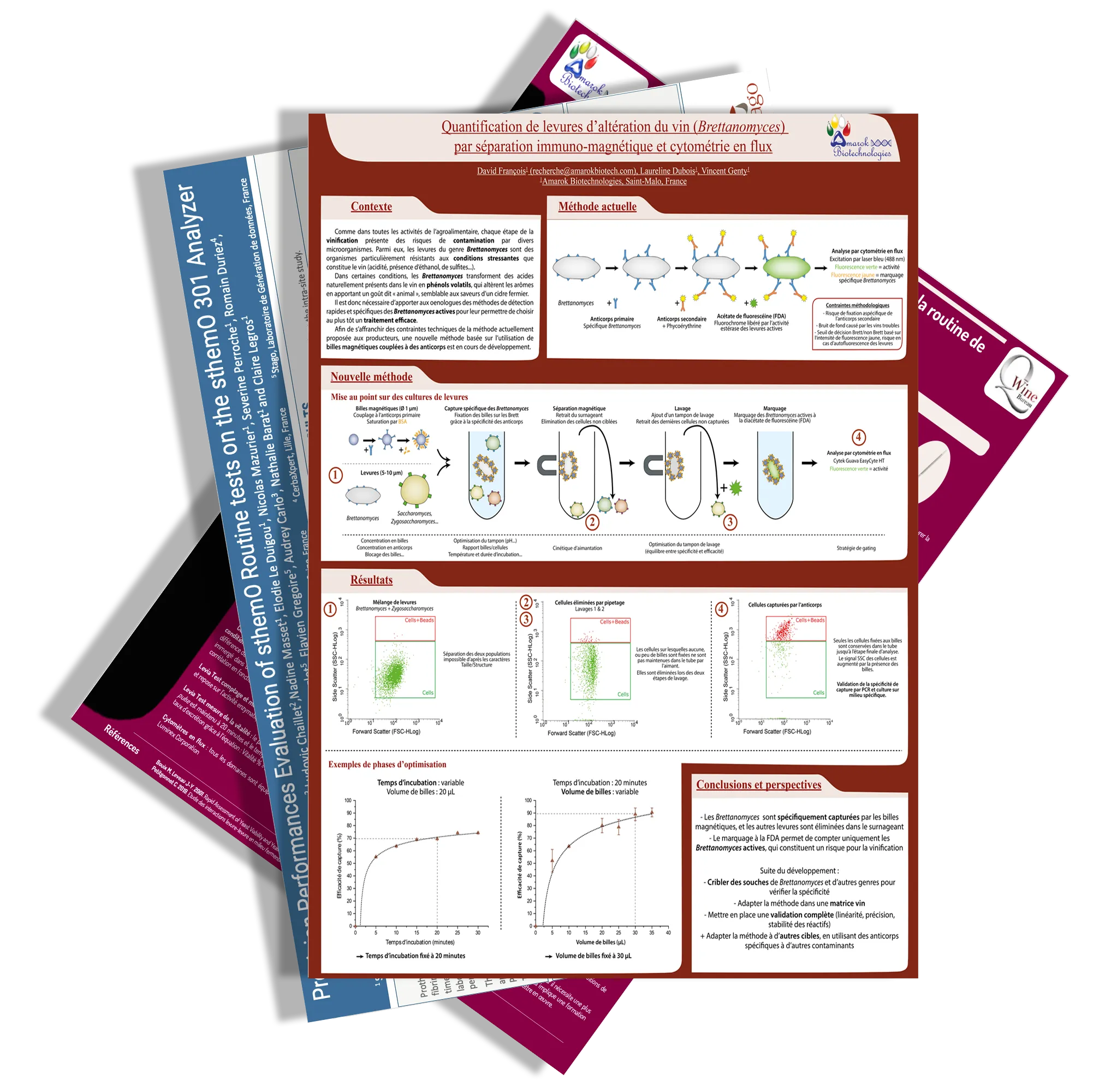Download our poster on measuring autofluorescence in wine yeasts using spectral cytometry
Find out how Amarok Biotechnologies was able to determine whether this fluorescence was due to a labeling artifact or whether it reflected the natural maturation of the yeasts during the winemaking process.


Yeast autofluorescence increases significantly as the cells age, reaching a maximum when the cells are dead. This phenomenon can bias analysis results if it is not differentiated from other background signals. We therefore set out to determine whether this fluorescence was due to a labeling artifact, or whether it reflected the natural maturation of the yeasts during the winemaking process. To do this, we used an advanced flow cytometry technology: spectral cytometry.
Spectral cytometry for measuring yeast fluorescence
Spectral cytometry, a state-of-the-art flow cytometry technique, is based on the use of detectors to capture the entire fluorescence emission spectrum. Spectral resolution is superior and sensitivity is enhanced compared to traditional flow cytometry methods. The identification and quantification of fluorescent signals in cells is therefore much more precise.
Our methodology for analyzing cell fluorescence signals
We have carried out several complementary protocols on a series of wines from various geographical origins, at different stages of aging or alcoholic fermentation:
- Analysis using the Levia Test method on a conventional cytometer (Cytek® Guava® Easycyte), to measure and evaluate the physiological state (enzymatic activity) of fermenting yeasts.
- Analysis on a spectral cytometer (Cytek® Northern Lights) without fluorescent dyes, to study autofluorescence generated under laser excitation (violet/blue or red).
- To simulate wine aging, yeast cultures were subjected to various stresses (thermal, chemical, nutritional) and analyzed using the same protocols.
Our observations on yeasts in alcoholic fermentation
Analysis of cell fluorescence signals using various cytometry techniques revealed that :
- Active cells are easily visualized using the fluorescence spectrum used in the Levia test (FDA specific).
- Autofluorescence is observed, by spectral cytometry, only on yeasts that have evolved in the vinous matrix (mainly in the red channels and whatever the excitation laser).
- Cells grown in culture medium (under various stresses) do not show the same autofluorescence in spectral cytometry, even after transfer to wine.
- The fluorescence signature is observed on all yeasts in the wine matrix, but is more pronounced in red wines than in whites.
Spectral cytometry enables accurate assessment of yeast viability and stress during vinification
The results of our study highlight the value of spectral cytometry for the precise analysis of cell fluorescence signals. By exploiting the entire emission spectrum, this technology characterizes yeasts by their fluorescence signature, the intensity of which reflects the cells’ enzymatic activity. It surpasses conventional methods in terms of resolution and sensitivity, revealing cell viability and stress.
Validation of Amarok Biotechnologies’ technological choices for monitoring alcoholic fermentation
Amarok Biotechnologies has been developing a flow cytometry-based strategy for monitoring alcoholic fermentations since 2015. This long experience allows us to conclude that each matrix has specific characteristics.
Thanks to the use of spectral cytometry, we are validating our technical strategy for distinguishing living, damaged or dead cells, essential for monitoring winemaking :
- Abandonment of the use of red fluorochromes in conventional cytometry
- Use of a cell mortality signature (in association with the green fluorescence generated by the degradation of fluorescein diacetate).
Technical prospects for wine fermentation control
Identifying the nature of fluorescent molecules and their precursors would provide a better understanding of alcoholic fermentation processes. This is all the more important as we assume the concomitance of different yeast stresses in the complex wine matrix during the production process. Further studies would be useful to deepen our understanding of these mechanisms and optimize the control of alcoholic fermentations.
Posters

Performance evaluation of the thrombophilia hemostasis test panel on the sthemO 301 analyzer
Posters

Evaluation of the accuracy of sthemO routine test performance on the sthemO 301 analyzer
Posters

Evaluation of analytical performance of the sthemO DDi M assay on the sthemO 301 analyzer
Contact
- +33 2 99 81 08 09
- 22 Avenue du Général Ferrié
- 35400 SAINT MALO


